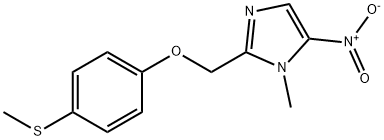CHEMICAL AND PHYSICAL PROPERTIES
| Boiling Point | 501 |
|---|---|
| Solubility | Practically insoluble |
COMPUTED DESCRIPTORS
| Molecular Weight | 279.32 g/mol |
|---|---|
| XLogP3 | 2.5 |
| Hydrogen Bond Donor Count | 0 |
| Hydrogen Bond Acceptor Count | 5 |
| Rotatable Bond Count | 4 |
| Exact Mass | 279.06776246 g/mol |
| Monoisotopic Mass | 279.06776246 g/mol |
| Topological Polar Surface Area | 98.2 Ų |
| Heavy Atom Count | 19 |
| Formal Charge | 0 |
| Complexity | 305 |
| Isotope Atom Count | 0 |
| Defined Atom Stereocenter Count | 0 |
| Undefined Atom Stereocenter Count | 0 |
| Defined Bond Stereocenter Count | 0 |
| Undefined Bond Stereocenter Count | 0 |
| Covalently-Bonded Unit Count | 1 |
| Compound Is Canonicalized | Yes |
PRODUCT INTRODUCTION
description
Human African trypanosomiasis (HAT, also colloquially referred to as sleeping sickness), caused by T. brucei gambiense and T. brucei rhodesiense, remains a moderate risk (>1/10,000 inhabitants per year in endemic areas) despite focussed control efforts. Transmitted by the bite of an infected tsetse fly, HAT is biphasic with a first (hemolymphatic) stage that progresses to a second (meningoencephalitic) stage in which patients experience progressively worsening neurological symptoms and eventually die if left untreated. Historical treatment options for meningoencephalitic HAT include [melarsoprol], [eflornithine], and [nifurtimox]/[eflornithine] combination therapy (NECT), though [melarsoprol] is highly toxic and each treatment requires lengthy infusions that are difficult to administer in resource-limited settings. Fexinidazole, which was originally developed in the 1970s/80s by Hoechst AG and subsequently rediscovered through the Drugs for Neglected Diseases Initiative (DNDi) in 2005, is the first all-oral treatment for first and second stage HAT caused by T. brucei gambiense. Fexinidazole received a positive opinion from the European Medicines Agency (EMA) in November 2018 and was approved by the FDA on July 16, 2021. It is currently marketed by Sanofi-Aventis.
